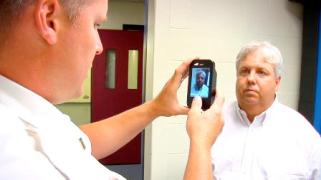You know what would really be cool is if companies handed out free smart phones when you signed a contract? I would classify it as a piece of kit as important as a rifle or radio that would be issued. Because as you read through all the reasons why the Army wants to give their soldiers smart phones, then you can see why something like this would be important for companies to think about doing. Especially if they want to share the battle space with the military.
Also, contractors already deploy with smart phones. I take an iPhone 3GS with me when I go on contract, and it is indispensable. Most contractors you work with now a days have these phones as well and take them out on gigs. This is nothing new and I have talked about this in the past. It’s just now you see the military recognizing the smart phone’s utility and potential, and they are the ones leading the charge of incorporating them into their operations. Good on them.
Another idea for companies is to develop applications that contractors can download for a contract. For example, DynCorp could have a DynCorp application that could serve as a portal for employees to access their intranet, all from a mobile phone. DynCorp could send out alerts to their employees and contractors through this application, and people could call or write back to the company with these devices. For travel arrangements or time sheets, this could also be done on the mobile phone through a really easy to use and understand company application. For secure communications, they could integrate Hushmail or something similar on their company application and the possibilities are endless.
The military could benefit from the companies having contractors armed with smart phones as well. An application could be set up for a specific Area of Operation in a war, and all companies would require that their contractors download that app on their phone. It could be set up as a secure means for the military and contractors to communicate with each other, and establish unity of effort through the real time exchange of information. Smart phones could be that thing that could connect private industry with the military in a war zone.
Apps like this could lead to more enemy killed, less fratricide incidents, and real time information exchanges that could assist in local COIN efforts. Contractors are a HUMINT resource that could really be exploited via smart phones and their applications.
A contractor AO specific app could also have the rules for the use of force (RUF) that could be constantly updated by the military in that AO, or that RUF could be sent to them by the company via a company app. Unity of effort all the way and as long as the military has a network established out there, companies could be brought into that as well.
The other thing that would be interesting with a company app or a company issued smart phone, is security. If you want your employees/contractors using these devices, they have to be secure. By channeling everyone through an app, a protected remote browser or company issued phone, a company information technology security team or contracted security team could stand a better chance of protecting the system. Because once you have have established a connection between the contractor and company, there will always be some group or person out there that will want to sabotage it or try to hack into it.
That last part is very important to remember, and there are numerous folks out there that are making it very easy for anyone to be a hacker. Easy to use programs like Firesheep, that allow folks to break into other people’s computers or phones via wifi are just one example of what I am talking about. (thanks to DVM for that story) As the military or companies delve further into integrating smart phones into their organizations, their phone and computer security personnel will be vital to the safeguarding of their operations. But the benefits still outweigh the negatives with this technology, and this is where the military (and private industry) is going. –Matt

Army sees smart phones playing important role
The service also views smart phone as a ‘force multiplier’ — and it wants to give you a free one
By Joe Gould and Michael Hoffman
Sunday Dec 12, 2010
The Army wants to issue every soldier an iPhone or Android cell phone — it could be a soldier’s choice.
And to top it off, the Army wants to pay your monthly phone bill.
To most soldiers, it sounds almost too good to be true, but it’s real, said Lt. Gen. Michael Vane, director of the Army Capabilities Integration Center. He said the Army would issue these smart phones just like any other piece of equipment a soldier receives.
“One of the options potentially is to make it a piece of equipment in a soldier’s clothing bag,” Vane said.
With the backing of officials such as Vane, efforts are underway around the Army to harness smart phones to revolutionize the way the service trains and fights.
Army-issued smart phones are already in the schoolhouse and garrison, in the hands of some students at Fort Leonard Wood, Mo.; Fort Lee, Va.; and at Fort Sill, Okla., under an Army program called Connecting Soldiers to Digital Applications. CSDA’s next step, already underway at Fort Bliss, Texas, is testing for the war zone.
In February, the Army plans to begin fielding phones, network equipment and applications to the first Army brigade to be modernized under the brigade combat team modernization program. That test will not be limited to smart phones but will include any electronic devices that may be useful to troops.
(more…)
![]()

